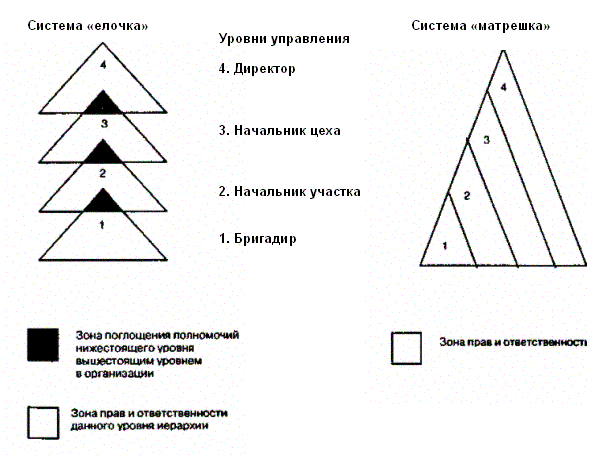home
 Management Management
 Management - Vikhansky OS Management - Vikhansky OS
|
Management - Vikhansky OS
2.6. The distribution of rights and responsibilities
The management practices applied in organizyatsiyah two distribution rights system and the responsibility or authority to the levels of the hierarchy. The first system is based on the principle of unity of subordination and its scheme of something like a "Christmas tree".
Historical and cultural roots "herringbone" systems are a combination of private ownership of land and based on respect and calculation relations reproduced in Western family between her older and younger members.
The principle of unity of the submission is that the employee should receive an order relating to the work performed, only one boss. Based on this system "Tree" is constructed so that the rights and responsibility of a superior head absorb only part of the rights and responsibilities of the head downstream.
This system is the basis of Weber's bureaucratic organization and is characterized by high precision in fixing the rights and responsibilities of each level of the head. It makes it easy to find the person responsible for the failure of the organization. The disadvantage of the system "Tree" is that in the framework of common functional departamentizatsii it weakens the functional right (Fig. 7.19).

Fig. 7.19. Distribution in the organization of rights and responsibilities for the system "Tree" and "matryoshka"
The second system - the system of dual or multiple submission ( "matryoshka") - has historically been built on a combination of public relations or joint ownership of land and relations, he played in Asian culture with families.
In contrast to the "herringbone" system "Matryoshka" is constructed so that the rights and responsibilities of supervisors fully absorb the rights and responsibilities of all subordinate leaders. Under this system, the rights and responsibilities are dispersed among many levels of the organization, and it's almost impossible to find the culprit for what happened. They can become a leader at any level, and it will not be determined within the framework of established policies and procedures, and the subjective opinions of superiors, pursuing their political goals. In Russia, this system was formed in the government during the reign of Ivan the Terrible, and one of its manifestations was the oprichnina. The Soviet system of management is also based on this property.
The system deliberately allows the presence of two or more persons having the same powers with respect to the control object. This situation takes a final decision on the very top of the organization and thus allows to carry out total control.


Comments
Commenting, keep in mind that the content and the tone of your messages can hurt the feelings of real people, show respect and tolerance to his interlocutors, even if you do not share their opinion, your behavior in terms of freedom of speech and anonymity offered by the Internet, is changing not only virtual, but real world. All comments are hidden from the index, spam control.